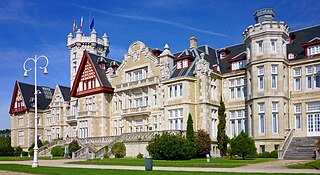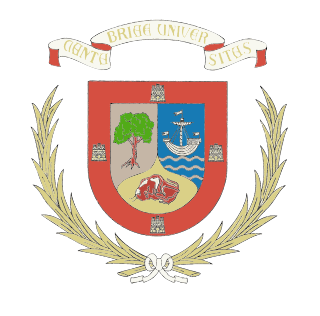
Cantabria is an autonomous community and province in northern Spain with Santander as its capital city. It is called a comunidad histórica, a historic community, in its current Statute of Autonomy. It is bordered on the east by the Basque autonomous community, on the south by Castile and León, on the west by the Principality of Asturias, and on the north by the Cantabrian Sea, which forms part of the Bay of Biscay.

Santander is the capital of the autonomous community of Cantabria, Spain. It has a population of 172,000 (2017). It is a port city located in the northern coast of the Iberian Peninsula, facing the Cantabrian Sea.

Legal deposit is a legal requirement that a person or group submit copies of their publications to a repository, usually a library. The number of copies required varies from country to country. Typically, the national library is the primary repository of these copies. In some countries there is also a legal deposit requirement placed on the government, and it is required to send copies of documents to publicly accessible libraries.
Spanish postal codes were introduced on 1 July 1984, when the Sociedad Estatal de Correos y Telégrafos introduced automated mail sorting. They consist of five numerical digits, where the first two digits, ranging 01 to 52, correspond either to one of the 50 provinces of Spain or to one of the two autonomous cities on the African coast.

A national library is a library established by a government as a country's preeminent repository of information. Unlike public libraries, these rarely allow citizens to borrow books. Often, they include numerous rare, valuable, or significant works. A national library is that library which has the duty of collecting and preserving the literature of the nation within and outside the country. Thus, national libraries are those libraries whose community is the nation at large. Examples include the British Library in London, and the Bibliothèque nationale de France in Paris.

Library and Archives Canada is the federal institution tasked with acquiring, preserving, and providing accessibility to the documentary heritage of Canada. The national archive and library is the 16th largest library in the world. The LAC reports to the Parliament of Canada through the Minister of Canadian Heritage.

The Archaeological Museum of Asturias is housed in the 16th century Benedictine monastery of Saint Vicente in Oviedo, Asturias, Spain. Its findings include collections of the Asturian Neolithic, Megalithic, Bronze Age, Iron Age, Astur hill fort culture, Roman period, and of the Gothic, Pre-Romanesque and Romanesque periods of the Kingdom of Asturias. The museum also includes sections of Asturian Ethnography, Heraldry, Medieval and Modern Epigraphy, Spanish Numismatics, a European Medal Section, and Armor.

The Biblioteca Nacional de España is a major public library, the largest in Spain, and one of the largest in the world. It is located in Madrid, on the Paseo de Recoletos.

The National Library of Colombia is a national library located in Bogota, Colombia. The library is a dependency of the Colombian Ministry of Culture.

University of Cantabria (UC), is a public university located in Santander, Torrelavega and Comillas in Cantabria, Spain. It was founded in 1972 and is organized in 15 schools and colleges.

Santander Airport, officially Seve Ballesteros–Santander Airport, is an international airport near Santander, Spain and the only airport in Cantabria. In 2018 the airport handled 1,103,353 passengers and 11,258 flights, far more than in 1995 when it handled only 180,000 passengers. Since then, the traffic has declined following the trend in Spanish airports and the decrease in operations by some of the companies.

The National Library of Nigeria came into operation in the mid-1960s with the enactment of the National Library Act of 1964 which was later replaced by Act No. 29 of 1970. Before the passage of the National Library Act, a series of educational conferences conducted in Ibadan served as the intellectual basis for the creation of a network of libraries funded by the federal government to provide accessibility of educational materials to Nigerians. A government advisory committee was later created concerning the necessity to develop a local repository of knowledge. The committee was charged with finding a way to aid the government in bringing to prominence the intellectual foundations of its policies, creating a national bibliographic center, and providing an arena for the promotion of knowledge. The committee was the first major formal body that called for a National Library as part of its recommendations. The government accepted the demands of the advisory committee and undertook the necessary steps to build a National Library.

The École Nationale des Chartes is a French grande école and a constituent college of Université PSL, specialising in the historical sciences. It was founded in 1821, and was located initially at the National Archives, and later at the Palais de la Sorbonne. In October 2014, it moved to 65 rue de Richelieu, opposite the Richelieu-Louvois site of the National Library of France. The school is administered by the Ministry of National Education, Higher Education and Research. It holds the status of a grand établissement. Its students, who are recruited by competitive examination and hold the status of trainee civil servant, receive the qualification of archivist-paleographer after completing a thesis. They generally go on to pursue careers as heritage curators in the archive and visual fields, as library curators or as lecturers and researchers in the human and social sciences. In 2005, the school also introduced master's degrees, for which students were recruited based on an application file, and, in 2011, doctorates.

Menéndez Pelayo International University is a public university with administrative headquarters in Madrid and campuses in Santander, Valencia, Barcelona, Cartagena, Cuenca, Granada, La Línea de la Concepción, Seville and Tenerife. The University also conducts classes at the Luis Seoane Foundation in A Coruña and the Huesca campus of the University of Zaragoza.

The Marucelliana Library or Biblioteca Marucelliana, is a public library, founded by the mid-18th century, and located on Via Camillo Cavour # 43, in Florence, region of Tuscany, Italy.

The Cantabrian Health Service is an autonomous public health organization which depends on the Government of Cantabria. It was created by the Law of Cantabria 10/2001 of December 28.

Íñigo Joaquín de la Serna Hernáiz is a Spanish politician and civil engineer. He was the Mayor of Santander between 2007 and 2016 and served as Minister of Public Works from 4 November 2016 to 1 June 2018.

The Interprovincial Council of Santander, Palencia and Burgos was a governing body established on 8 February 1937 to coordinate the Republican areas in Cantabria, Palencia and Burgos during the Spanish Civil War. The council was dissolved in August 1937 after the occupation of the region by Nationalist forces.

The Santander fire of 1941 was a natural disaster that occurred in the Spanish city of Santander during the early morning hours of 15 February to 16 February 1941. Occurring decades after the explosion of the steamship Cabo Machichaco (1893), it is considered the most devastating fire in the history of the city.

The Port of Santander, Cantabria (Spain), is located in the Cantabrian Sea, specifically in the Bay of Santander, in the municipalities of Santander, Camargo and Marina de Cudeyo. It is managed by the Port Authority of Santander, whose current president is Francisco Martín Gallego, under the public entity Ports of the State and in turn administered by the Ministry of Transport, Mobility and Urban Agenda. It belongs to the maritime province of Santander (ST). Santander District (ST-4).



















